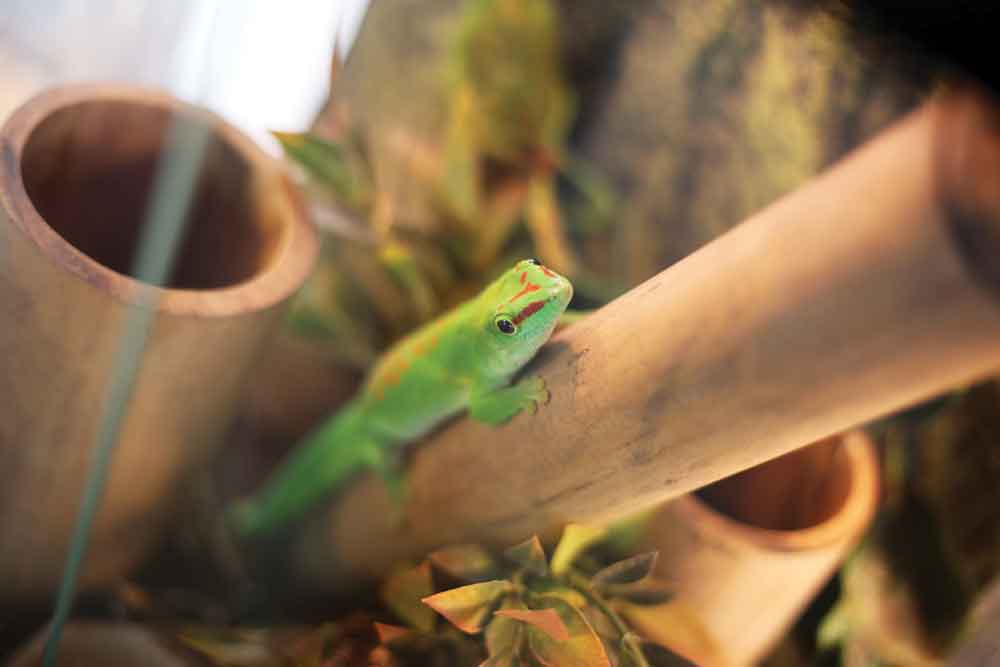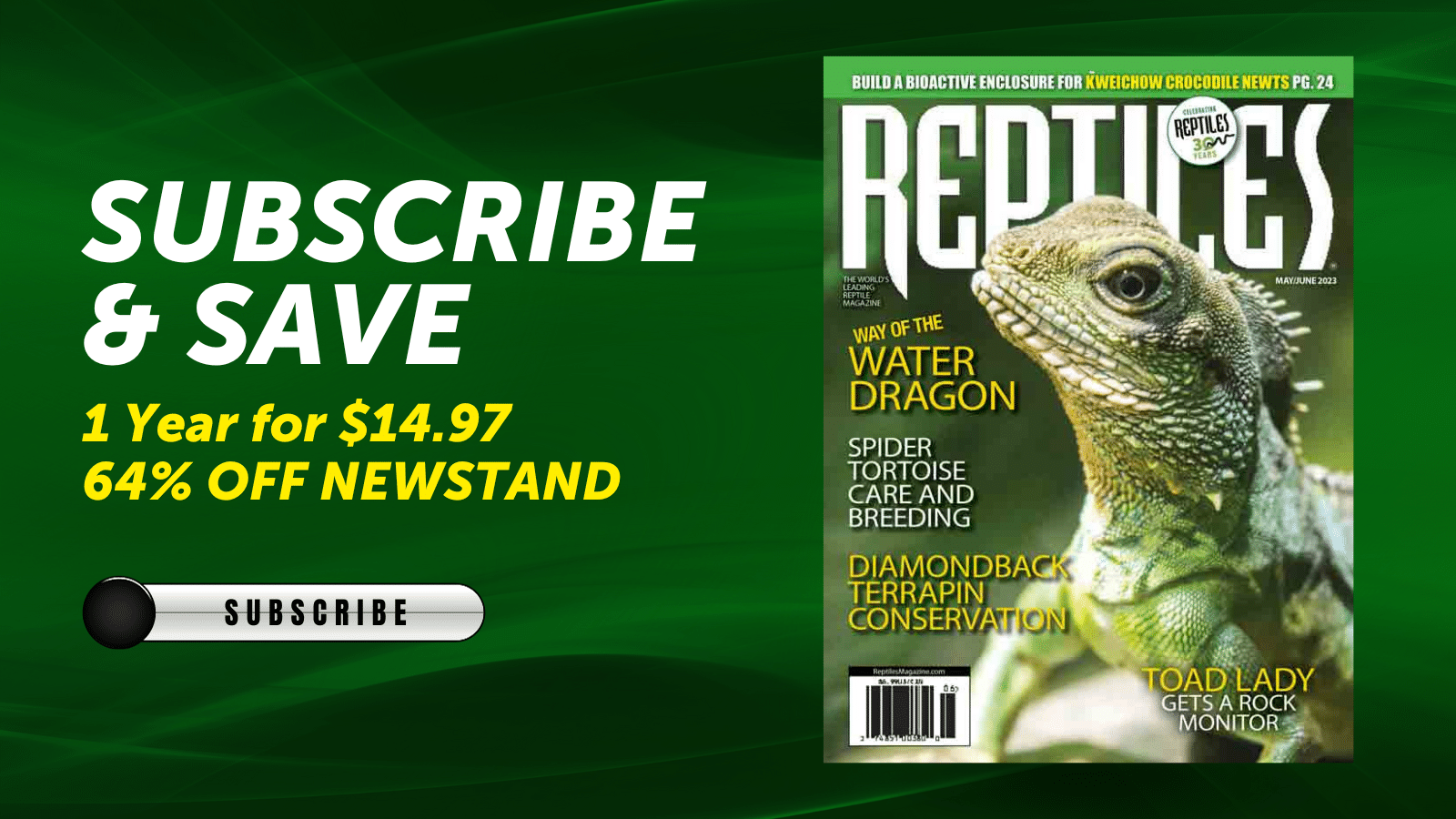Geckos of the Phelsuma genus are some of the most striking geckos amongst reptile keepers.
Day geckos are found on the islands in the southwest region of Indian Ocean. They belong to the Phelsuma genus, of which there are more than 80 species. Active during the day, these geckos have toe pads that enable them to walk on vertical and inverted surfaces. The toe pads have tiny lamellae which enable them to walk on surfaces such as bamboo and glass. Here we present three day geckos, all of which are popular amongst reptile keepers and captive bred. The Standing’s day gecko (Phelsuma standingi), the gold dust day gecko (Phelsuma laticauda) and the Madagascar giant day gecko (Phelsuma grandis) are all native to Madagascar, with the gold dust day gecko also found on the Comoro and Mascarene islands. These geckos are gaining in popularity due in large part to their beauty. In my opinion, they are probably the most striking of the geckos in the hobby. Captive bred specimens are available from breeders, though they are not as popular as the other gecko species.
Standing’s Day Gecko (Phelsuma standingi)
The Standing’s day gecko, (Phelsuma standingi) is an arboreal gecko native to southwest Madagascar. It is in the family Gekkonidae and is a diurnal species. It is one of the largest species of day gecko, rivaling the Madagascar day gecko in size. It can grow to 8 to 10 inches in length, with exceptional individuals growing even longer. It is found in arid areas of southwest Madagascar, notably around the Andranolaho, Sakaraha municipalities of Madagascar as well as in the Zombitse-Vohibasia National Park. The juveniles are brightly colored and can have multiple colorations and stripes, ranging from green to brown to turquoise blue. Adults become more muted in coloration, but are still striking. The Standing’s day gecko is not as popular as the Madagascar giant day gecko or the gold dust day gecko but they are captive bred and are sold at reptile shows and from breeders who specialize in them.
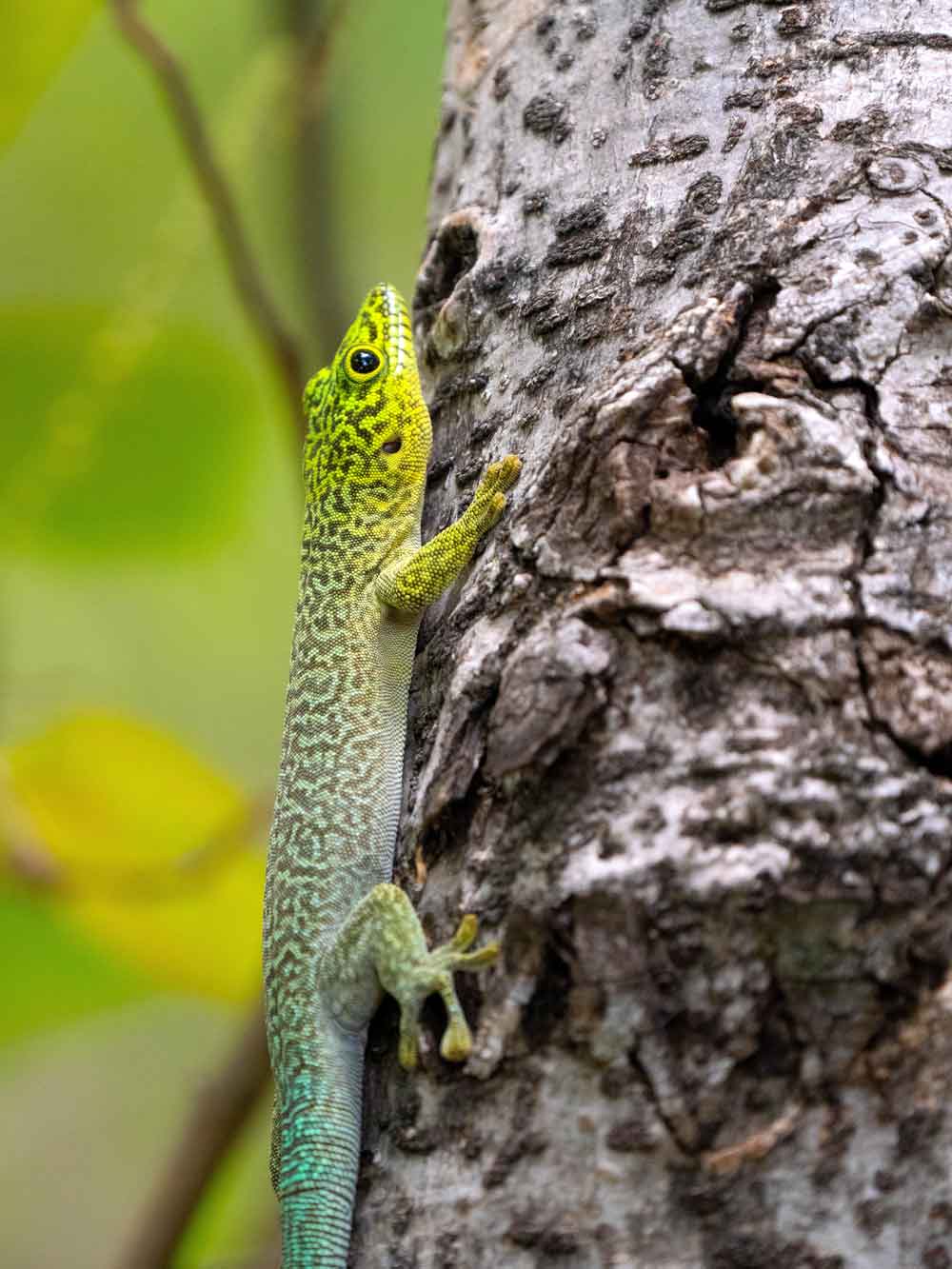
Standing’s day gecko. Photo by Vladislav T Jirousek/Shutterstock
Day Gecko Enclosure
Being an arboreal species that moves about quite a lot, adult Standing’s day geckos should be housed in a large vertical enclosure designed for arboreal reptiles. An enclosure size of at least four feet high and four feet long is ideal for this large gecko species. A 4’x 2’x 4’ enclosure will provide ample room for your gecko to move about. Young and juvenile day geckos can be housed in smaller enclosures of about 18” x 18” x 36.” Add plenty of climbing apparatus such as tree branches and large logs throughout the enclosure. Use several tree branches and logs that are close to the height of the enclosure. This will give your Standing’s day gecko plenty of room to move vertically and give them access to UVB, which is necessary for their health and well-being. A naturalistic or bioactive enclosure is the ideal enclosure solution for this species. They will use every inch of the enclosure, making it fun to watch this species move about during the day.
Substrate
The purpose for substrate in your Standing’s day gecko enclosure is more to help with humidity as this species is highly arboreal and will spend most of its life above the substrate. A nice bioactive substrate will provide nutrients for live plants and also your clean-up crew. This will also help with humidity. You can create a bioactive substrate with sphagnum moss, tree fern fiber, Orchid bark, peat moss and charcoal. Conversely you can combine elements of the classic ABG mix with herp specific options such as Reptisoil and EcoEarth. If you are building out a bioactive enclosure for your Standing’s day gecko, a minimum of 4 to 6 inches of substrate should suffice for most plants. If you are going the naturalistic route with the enclosure, 2 to 4 inches of substrate is sufficient.
Temperature/Lighting
The Standing’s day gecko should be housed in an enclosure with an ambient temperature of 75 to 85 degrees Fahrenheit (23.9 to 29.4 degrees Celsius) with a basking area of around 90 degrees Fahrenheit (32.2 degrees Celsius). Night time temperatures should not drop below 70 degrees Fahrenheit (21.1 degrees Celsius).
Unless you are housing your Standing’s day gecko outdoors in warm climates with plenty of sun, such as in South Florida, a UVB lamp is an absolute necessity. The Standing’s day gecko is a Ferguson Zone 3 reptile. It is an open or partial sun basker, basking in full sunlight in the morning and early afternoon and at mid day. Its average exposure index is 1.0 to 2.6. The UVB output is dependent on the distance of the UVB lamp to the distance of the reptile in the enclosure. This is why you should consider climbing branches so your gecko can move to the optimum location for UVB absorption. A T5 HO bulb, such as Zoo Med’s Reptisun 5.0 with 5 percent UVB will enable your gecko to synthesize Vitamin D3 more naturally. Invest in a Solar Meter so you can determine where in the enclosure the reptile safe basking area is and adjust the basking spot accordingly.
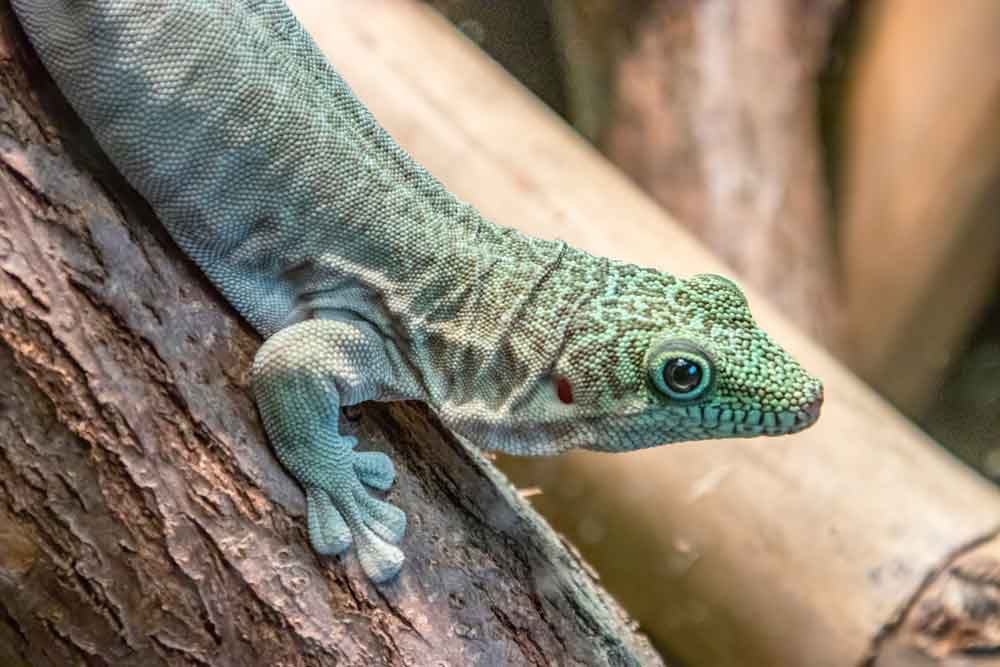
Phelsuma standingi. Photo by Danny Ye/Shutterstock
Feeding
The Standing’s day gecko is an opportunistic eater. It feeds on insects, nectar and rotting fruit in the wild. In captivity, you can feed them commercial crested gecko foods from the major manufacturers as well as crickets, dubia roaches and mealworms that are gut loaded and dusted with vitamins and calcium. Juveniles should be fed live pinhead crickets/small dubia roaches daily. The mealworms can be left in a deli cup, enabling the lizard to forage. With the crickets, ensure that they are eaten and remove any uneaten crickets. Give them access to crested gecko foods daily on an elevated ledge attached to the enclosure wall or on one of the branches or large logs. The key here is to keep the foods elevated. Adults can be fed two or three large crickets/dubia roaches and mealworms two to three times a week. The crested gecko foods should be available the days you aren’t feeding the live insects.
Ideal Keeper/Handler
The Standing’s day gecko is a stunning gecko species that is ideal for intermediate to advanced keepers. They aren’t really handleable and are best kept as a display animal. They are large geckos like the Madagascar giant day gecko, so keep this in mind when choosing the enclosure. They need the space to move about. They don’t do well in groups unless you have a pair, but then you may have eggs to consider in the future and you may have to prepare for that. Some folks keep females together, given the enclosure is large enough. If aggression is noted, you will have to separate them into individual enclosures. With proper care, these geckos can live up to 10 years and more.
Madagascar Giant Day Gecko (Phelsuma grandis)
The Madagascar giant day gecko is the largest and arguably the most popular gecko in the Phelsuma genus. They are large, growing to nearly a foot in length, including the tail and are an inquisitive and beautiful gecko. Native to Madagascar’s northern and northwest regions, Phelsuma grandis has also been introduced to Florida, Hawaii and the Reunion Islands. This species is widely captive bred and range in price from $100 to $1,000 on reptile auction sites. While wild caught Phelsuma grandis are also available, captive bred are always the best choices for the majority of those interested in keeping this species.
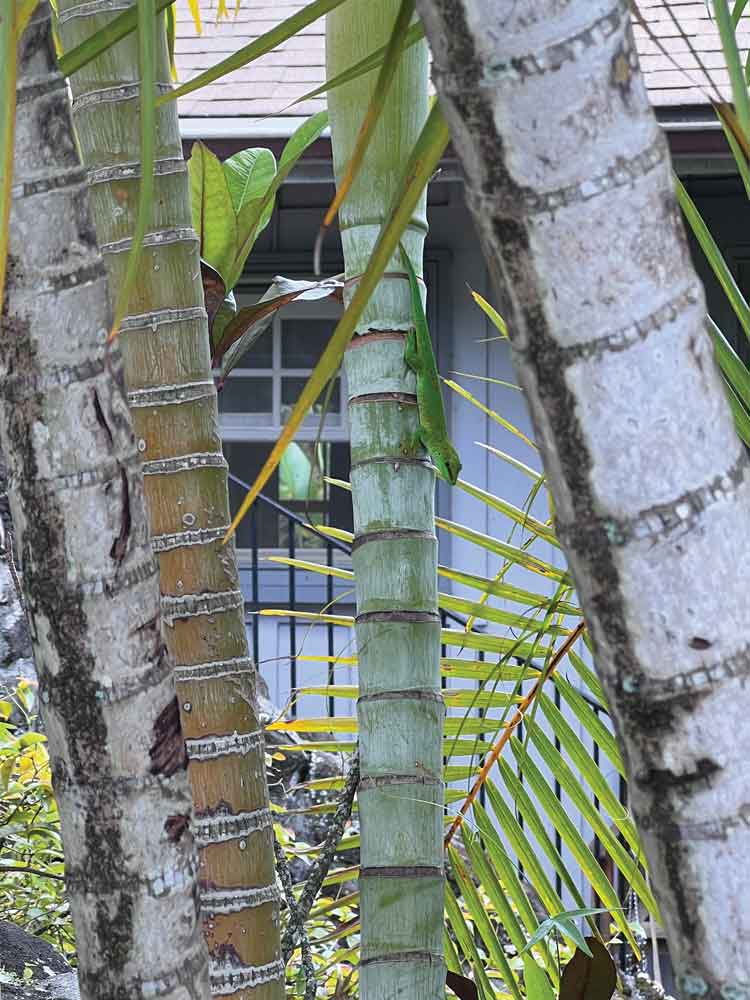
Madagascar giant day gecko. This individual is about 10 inches in length. Photo by John Virata
Enclosure
The days of keeping these geckos in small, cramped vertical enclosures are long gone. I have observed this species in the wild in my summer home in Manoa Valley, Hawaii for the last 10 years and these geckos move about quite a bit. I observed one specimen who had torn skin on its cheek, move during the course of two days, from the car port in front of the house, to the front porch on the ground floor and then into the backyard on the lanai, which is easily 200 feet of travel. As such, provide the largest enclosure you can for a single male, female or pair.
You can keep a juvenile in smaller enclosures of 18” x 18” x 36” until it outgrows it. After this, upgrade the enclosure to a 4’x 2’x 4’ or even a 4’x 2’x 6’ enclosure as this will provide ample room for your gecko to move and jump from branch to branch. The enclosure should include climbing branches or bamboo standing vertically and criss-crossed so your gecko can move about the enclosure. Large cork rounds standing vertically are also ideal for moving about and provide excellent hiding spots. As with many lizard species, do not keep two males in the same enclosure, as these reptiles will fight.
Substrate
The Madagascar giant day gecko’s enclosure requires moderate to high humidity, so choose a substrate that will help promote a humidity range of between 62 and 70 percent. The substrate is more to help with humidity as this species is highly arboreal and will spend most of its life above the substrate. A nice bioactive substrate will provide nutrients for live plants and your clean up crew will eat the dead plant and gecko droppings. Create a mix of substrate that includes orchid bark with sphagnum moss, tree fern fiber, peat moss and charcoal. Layer this on top of some BioBalls and a substrate screen for drainage. If you are building out a bioactive enclosure for your gecko, a minimum of 4 to 6 inches of substrate should suffice for most plants. If you are going the naturalistic route with the enclosure, 2 to 4 inches of the same combination substrate works well. You can also use a mister to help with humidity, just don’t let the enclosure get soaking wet. You will have to adjust the mister to coincide with the humidity requirements.
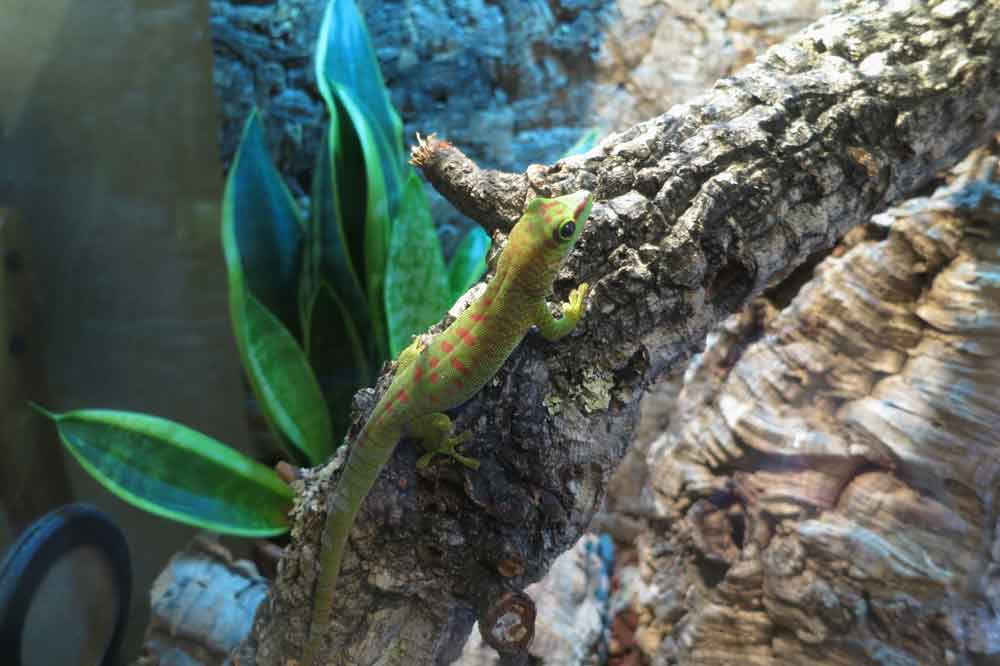
A giant day gecko on cork bark. Photo by Scink /Shutterstock
Temperature/Lighting and UVB
Madagascar giant day geckos are diurnal sun lovers. They are a Zone 3 reptile on the Ferguson Zone scale, meaning the gecko is a partial/open sun basker. Choose a UVB light with a Zone range UVI 1.0 to 2.6 with a maximum UVI 2.9 to 7.4. The UVB output is dependent on the distance of the UVB lamp to the distance of the reptile in the enclosure. This is why climbing branches are imperative inside the enclosure so the gecko can move to the optimum location for UVB absorption.
A T5 HO bulb, such as Zoo Med’s Reptisun 5.0 with 5 percent UVB will enable your gecko to synthesize Vitamin D3 more naturally. Invest in a Solar Meter so you can determine where in the enclosure the reptile safe basking area is and adjust the basking spot accordingly. Maintain a temperature of about 75 to 80 degrees Fahrenheit (23.9 to 29.4 degrees Celsius) during the day with a basking light temperature of about 85 degrees. You can achieve this with a basking spot lamp during the day and an infrared heat lamp at night. Invest in a digital hygrometer. This will give you accurate humidity and temperature readings at a glance. In Hawaii where I’ve observed these geckos in the wild in the summer months on Oahu, the average high temperature is 81 degrees with 68 percent humidity in Manoa Valley where these geckos have become established.
Feeding Day Geckos
In the wild, Madagascar giant day geckos are opportunistic omnivores that will feed on insects and other invertebrates as well as fruit matter. I watched a giant day gecko take down a very large centipede in Hawaii. It took the gecko the entire afternoon to swallow it down. I also watched a pair of giant day geckos feed on papaya seeds I had put out on the lanai to dry out, so their diets are varied. They should be fed a variety of live insects and commercial fruit and insect-based gecko foods and fresh fruits such as smashed papaya and banana.
Hatchling and juvenile Madagascar giant day geckos should be fed gut-loaded pinhead crickets no longer than the width of the gecko’s head, dusted with reptile vitamins. You can also feed them mealworms. Feed them three to five insects three days a week and alternate with commercial gecko foods and the fresh fruits mentioned. Remove any uneaten crickets. Adult geckos should be fed adult crickets or dubia roaches as well as commercial fruit and insect-based gecko foods every other day. Don’t overfeed them or they can develop health issues. Use a magnetic elevated dual feeding platform for the commercial foods and the fresh, mashed fruits. The other bowl can be for fresh water.
Ideal Keeper/Handler
The Madagascar giant day gecko is ideal for those who have several years of experience keeping reptiles and understand the importance of humidity, lighting and UVB, as this species is specific in its needs with respect to these elements. They are also more of a hands off species, though people do have success in hand feeding them and occasionally handling them. They just aren’t a hardy species handling wise like a leopard gecko or crested gecko. If you have the room to house this species in a nice sized enclosure and have the wherewithal to create a beautifully scaped vivarium for these giant day geckos, you will be rewarded with many years of enjoyment keeping a Phelsuma grandis.
Gold Dust Day Gecko (Phelsuma laticauda)
The gold dust day gecko is the smallest species of the gecko trio, averaging just 4-5 inches in total length. Its beautiful colorations, however more than make up for its diminutive size, and that coloration makes it one of the more popular day geckos amongst reptile keepers. The gold dust day gecko, like the Madagascar giant day gecko and the Standing’s day gecko, is from Madagascar. It is also native to the Comoro Islands and the Mascarene Islands, and is an introduced species in the Hawaiian Islands. Primarily arboreal, the gold dust day gecko feeds on small insects as well as nectar and soft fruit. On Oahu in Hawaii, you can seen often see a small army of these little lizards at shave ice stores around the island, feeding on the sweet flavors of discarded shave ice containers. The gold dust day gecko is bright green in coloration and has red markings on its head and three red crayon scrawls and smaller red spots just above the rear legs. Smatterings of “gold dust” occur around and below the neck area to mid back. Active during the day, this species makes a great display animal in a bioactive or naturalistic terrarium.
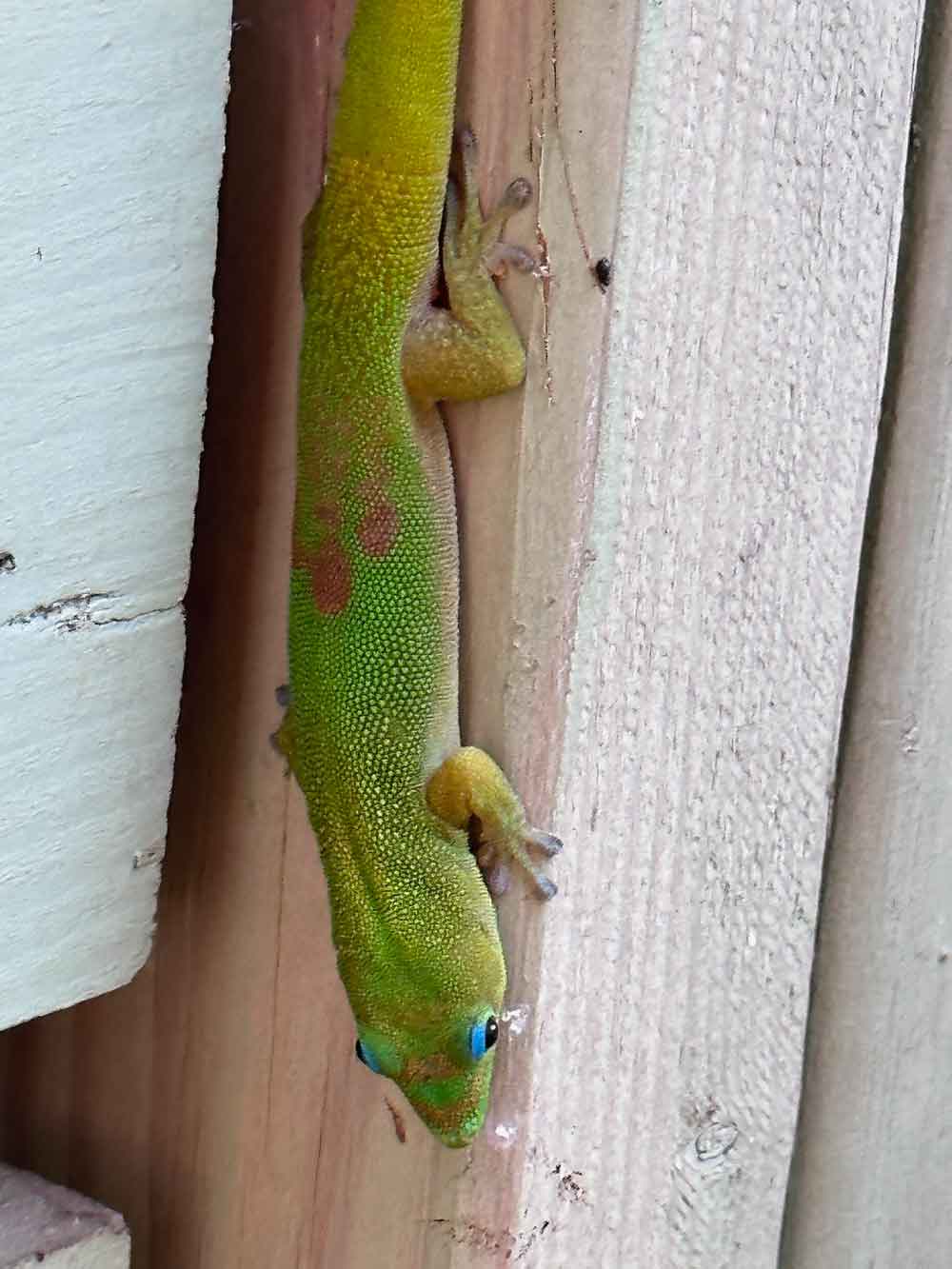
Gold dust day gecko. Photo by John Virata
Enclosure
The gold dust day gecko is semi-arboreal. And adaptable. I have observed them on the floor of the lanai in my backyard as well as in the lychee tree in the front. For a small lizard, they are at home on the ground and in the trees. You can house a young male or female in a 12” x 12” x 18 vertical enclosure and move up to an 18” x 18” x 36” when it reaches adult size. Furnish the enclosure with climbing branches like bamboo and cork flats set up vertically and live snake plants if possible for them to perch on and move about.
Substrate
The gold dust day gecko’s enclosure requires moderate humidity, so choose a substrate that will help promote a humidity range between 60 and 70 percent. The substrate and live plants should be used to help with humidity. This species is semi-arboreal so use some nice sturdy plants with broad climbable leaves for them to climb up. A nice bioactive substrate will provide nutrients for the live plants and your clean up crew will eat the dead plant matter and gecko droppings. Create a mix of substrate that includes Orchid bark with sphagnum moss, tree fern fiber, peat moss and charcoal. Conversely you can combine elements of the classic ABG mix with herp specific options such as Zoo Med’s Reptisoil and EcoEarth. Layer this on top of some BioBalls and a substrate screen for drainage. If you are building out a bioactive enclosure for your gecko, a minimum of 4 to 6 inches of substrate should suffice for most plants. If you are going the naturalistic route with the enclosure, 2 to 4 inches of the same combination substrate works well. You can also use a mister to help with humidity, just don’t let the enclosure get soaking wet. You will have to adjust the mister to coincide with the humidity requirements.
Day Gecko Temperature/Lighting and UVB
Your gold dust day gecko is diurnal and spends much of its time in the sun. They are a Zone 3 reptile on the Ferguson Zone scale, meaning the gecko is a partial/open sun basker. Choose a UVB light with a Zone range UVI 1.0 to 2.6 with a maximum UVI 2.9 to 7.4. The UVB output is dependent on the distance of the UVB lamp to the distance of the reptile in the enclosure. This is why climbing branches are imperative inside the enclosure so the gecko can move to the optimum location for UVB absorption. A T5 HO bulb, such as Zoo Med’s Reptisun 5.0 with 5 percent UVB will enable your gecko to synthesize Vitamin D3 more naturally. Invest in a Solar Meter so you can determine where in the enclosure the reptile safe basking area is and adjust the basking spot accordingly. Maintain a temperature of about 75 to 80 degrees Fahrenheit (23.9 to 29.4 degrees Celsius) during the day with a basking light temperature of about 85 degrees. You can achieve this with a basking spot lamp during the day and an infrared heat lamp at night. Invest in a digital hygrometer. This will give you accurate humidity and temperature readings at a glance.
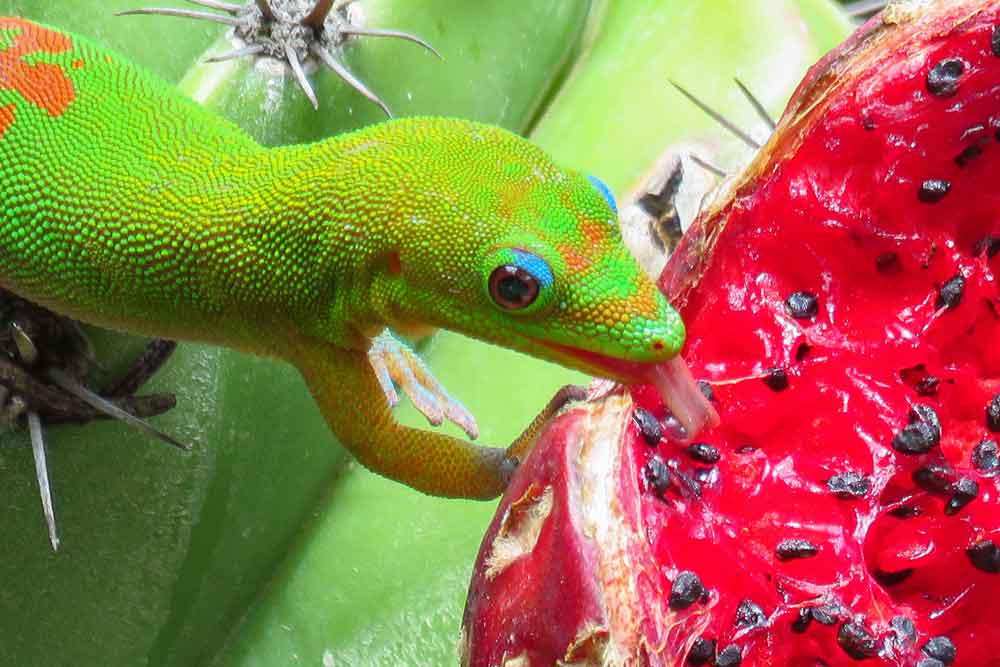
Gold dust day gecko feasting on some dragonfruit. Photo by The World Traveller/Shutterstock
Feeding
The gold dust day gecko is an omnivore and feeds on insects and fruit nectars in the wild. In captivity, feed your hatchling and young gold dust day geckos pinhead crickets or fruit flies dusted with a reptile vitamin and calcium. When they grow you can feed them gut-loaded 1/4 inch crickets. You can also feed them small dubia roaches and black soldier fly larva. You can use either an elevated platform feeding dish, or a feeding dish on the floor of the enclosure. They will eat from both locations. Alternate feeding the geckos live insects and a commercial gecko diet for fruit loving geckos. This will ensure a balanced diet.
Ideal Keeper/Handler
The gold dust day gecko is an ideal first gecko from the Phelsuma genus and makes for a beautiful display animal in a bioactive or naturalistic enclosure. Practice minimal handling of this species. You can try to “train” them to eat from your hand while your hand is in the enclosure.

